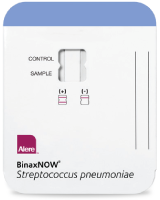Overview
 Community-acquired pneumonia (CAP) is a common disease associated with considerable mortality and morbidity and accounts for high antibiotic consumption. Among adults in industrialized countries, pneumococcal pneumonia still accounts for at least 30% of all cases of community-acquired pneumonia admitted to the hospital, with a case fatality rate of 11-44%.
Community-acquired pneumonia (CAP) is a common disease associated with considerable mortality and morbidity and accounts for high antibiotic consumption. Among adults in industrialized countries, pneumococcal pneumonia still accounts for at least 30% of all cases of community-acquired pneumonia admitted to the hospital, with a case fatality rate of 11-44%.
Although numerous pathogens can cause CAP, Streptococcus pneumoniae remains the leading bacterial cause worldwide and the leading cause of mortality. It is also the most likely pathogen in patients with CAP admitted to the ICU.
The Problem
Current evidence supports that antibiotics should be administered 4-6 hours after the patient arrives at the hospital. Because results of definitive diagnostic tests for pneumonia are not available for several days, broad-spectrum antibiotics are prescribed. The yield of traditional microbiological investigations for diagnosis of CAP is limited for several reasons:
- routine difficulties in obtaining good-quality sputum
- uncertainty of the value of its culture results
- low sensitivity of blood cultures
- administration of antibiotics before samples collection
Consequences
The delay of a definitive and focused diagnosis may cause patients to be at risk for adverse reactions due to the empirical use of broad-spectrum antibiotics. Some broad-spectrum antibiotics, such as cephalosporins or fluoroquinolones, used to treat CAP have been strongly associated with Clostridium difficile-associated diarrhea (CDAD) and methicillin-resistant Staphylococcus aureus (MRSA).
Rapid Testing
Early and rapid diagnosis of CAP would allow more directed therapy and confidence in appropriate treatment for a majority of patients. Using an appropriate pathogen-focused antibiotic or narrowing empirical therapy may decrease cost, drug adverse events, and the threat of antibiotic resistance.
A rapid and simple urine antigen test (UAT), Alere BinaxNOW® S. pneumoniae based on immunochromatographic technique, is widely available to detect the C-polysaccharide antigen of S. pneumoniae in just 15 minutes. The high specificity, positive predictive value, and positive likelihood ratio makes Alere BinaxNOW S. pneumoniae a useful tool in the treatment of adult patients with CAP.
In one study, the Alere BinaxNOW UAT was the only diagnostic test positive for S. pneumoniae for 32 patients. Had this test not been available, these patients would have received diagnoses of pneumonia due to atypical pathogens or unknown etiology, and according to current guidelines, would have received broad-spectrum antibiotic therapy. However, these patients fared just as well receiving penicillin.
Alere BinaxNOW S. pneumoniae is advocated by numerous worldwide CAP guidelines including IDSA/ATS, BTS, SPILF and SEPAR. The IDSA/ATS CAP guidelines conclude that only 50% of Alere BinaxNOW S. pneumoniae UAT positive patients can be diagnosed by conventional methods.
Antimicrobial Stewardship Program Diseases
Featured Product

Alere BinaxNOW Streptococcus pneumoniae Antigen Card
Rapid urine tests employ immunochromatographic technology that provides accurate detection of the specific antigen in urine.
